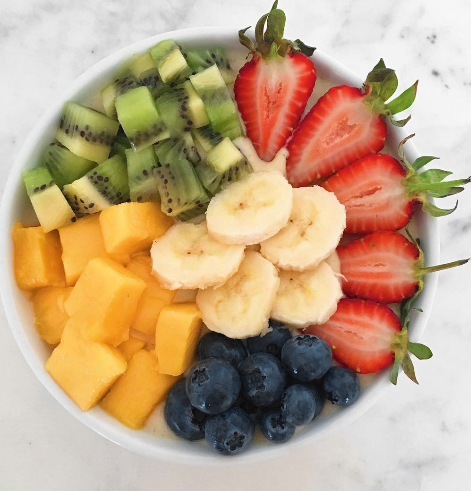
Will an apple a day keep the doctor away? Or will it do the complete opposite?
For quite some time now it has been recommended that we eat two serves of fruit a day. Recently however, attention has been drawn to the sugar in fruit and whether in fact we should be eating fruit at all!
Are you confused? Have a read of my thoughts on the topic as featured in Sarah Berry’s Daily Life article – “What is the truth about sugar in fruit?”
Most of us were raised with the message that we needed to eat more fruit and veg.
With new research finding that only two per cent of us manage to eat enough of them, it was a necessary message.
One that got warped along the way.
Perhaps when sugar, the high levels of sugar in fruit and specifically the type of sugar found in fruit came under fire.
Certain diets, like the G.I. Diet, warn people away from many fruits, like pineapple and even high-glycaemic-index vegetables like pumpkin.
A new study found fruit juice can contain more sugar than soft drink. And, it has been argued that fruit sugar, or fructose, converts directly into fat.
Cue headlines that eating apples will make you obese, etcetera etcetera.
So what is the truth about sugar in fruit and how much of it we should eat?
Despite reports to the contrary, I Quit Sugar’s Sarah Wilson eats fruit. Even Robert Lustig, the pediatric endocrinologist who has become known as the “anti-sugar guy”, is pro-fruit.
“I have nothing against fruit, because it comes with its inherent fibre, and fibre mitigates the negative effects,” he has said. “The way God made it, however much sugar is in a piece of fruit, there’s an equal amount of fibre to offset it.”
He has one exception to this rule.
“Grapes are just little bags of sugar. They don’t have enough fibre for the amount of sugar that’s in them. But I have nothing against real food, and that includes real fruit. Eat all the fruit you want.”
It’s not just the fibre in fruit that makes a difference and offsets the fructose content.
“I feel there’s probably a bit of miscommunication on the nutrition in fruit and fructose,” says Sydney nutritionist Jacqueline Alwill. “I personally don’t agree with labelling fruit a bad food simply because of its (fructose) sugar content.
“Fruit also offers incredible nutrition derived from vitamins, minerals and antioxidants and these are positives.”
Dietitian Melanie McGrice says that prior to the release of the revised dietary guidelines released in 2013, there was a review of 55,000 evidence-based studies. “The result showed the importance of fruit as part of a healthy diet. It significantly reduces the risk of heart disease and cancer – two of the biggest killers in Australia.”
The guidelines recommend two serves of fruit a day. Stick to that and you’re sweet, Alwill says.
“Over consumption of fruit is where the problem with metabolising fructose occurs. We can manage our fructose intake simply by moderating the amount of fruit we eat which is far better than demonising it.”
Alwill reminds that overconsumption is easier with dried fruit, tinned fruit and juices.
“If you think about how many pieces of fruit have to go in to one juice (say four to five) versus eating just one, it becomes pretty clear what is better for you,” she explains, adding that juicing removes the fibre in the fruit meaning the effect of sugar (fructose) on blood glucose levels is more rapid.
“Fibre slows the rate at which our bodies absorb sugar into the blood stream. So a pure fruit juice is absorbed quickly giving your blood sugar a spike and then a sudden drop.”
Where does that leave the fruit message?
Get fruity, says David Katz, the director of Yale’s Prevention Research Centre.
“Of course fruit is good for us! Maybe it’s not as good for us as vegetables, and maybe we should have been saying ‘vegetables and fruits’ rather than ‘fruits and vegetables’ all along,” he says.
“But fruit is good for us. Overwhelmingly, diets and health in the U.S. stand to improve with the addition of more fresh fruits, and the foods the fruits displace.
“After all, if you have an apple or banana as a snack, you not only benefit from the apple or banana; you benefit from the avoidance of the chips or cheese puffs you might have eaten instead.”
What is one serve of fruit?
One medium apple, banana, orange or pear
2 small apricots, kiwi fruits or plums
1 cup diced or canned fruit (no added sugar)
Or only occasionally:
125ml (½ cup) fruit juice (no added sugar)
30g dried fruit (for example, 4 dried apricot halves, 1½ tablespoons of sultanas)
Fruit and fructose:
Lower fructose fruits include blueberries, raspberries, grapefruits, honeydew melon and kiwi fruit, Alwill says. High fructose fruits include bananas, mangoes, cherries and grapes.
read more at : http://www.dailylife.com.au/health-and-fitness/dl-nutrition/what-is-the-truth-about-sugar-in-fruit-20150428-1muz63.html
As seen in







Get nutritious recipes
straight into your inbox!
Send your details now to receive Melanie’s recipes designed around a range of dietary needs including improved fertility, weight loss, general heath and wellbeing through improved nutrition. Receive the recipes specific to your needs.
